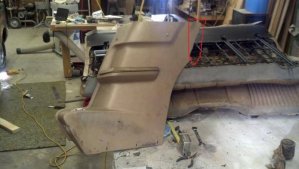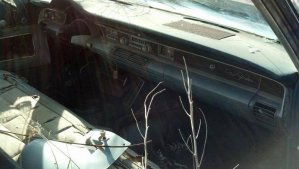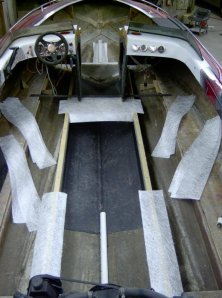Here is the situation. I have started dissembling the interior. I have come across that some idiot tried to remove the back panel without first removing the seats and literally tore a section of the panel that was mounted to a bracket for support. They also ripped a crack at the arm rest where they obviously trying to yank it out of the car.
I little side note, I have a theory on most of the bumps and dents on the car. First, I found out over the holidays from the PO that the first owner has actually passed way (the one on the Certicard) I was really hoping to have a chance to meet her. I found out that her son drove it a year in college and that it was in great shape before he got ahold of it.
Anyway back to my theory, there was one of many dents on the passenger side, one behind this panel. This may have been one of the first they tried to pound out from the inside. I can see some frat boy buddy of his say I can fix that before your Mom would ever see it, for a 6 pack of beer, take 2 screws out and then yank on it until he tore it out.
OK now that I totally hijacked my own thread the actual question. Can I make a repair to restore the integrity of the panel? I don’t even have the bracket but I could fabricate one if I can't find one, but the piece of the panel is gone too. One of the advantages of the repair, is it would be completely behind the seat so it would not have to be perfect.

This photo shows the left side and how it's mounted in the car and what I would like to repair.


I little side note, I have a theory on most of the bumps and dents on the car. First, I found out over the holidays from the PO that the first owner has actually passed way (the one on the Certicard) I was really hoping to have a chance to meet her. I found out that her son drove it a year in college and that it was in great shape before he got ahold of it.
Anyway back to my theory, there was one of many dents on the passenger side, one behind this panel. This may have been one of the first they tried to pound out from the inside. I can see some frat boy buddy of his say I can fix that before your Mom would ever see it, for a 6 pack of beer, take 2 screws out and then yank on it until he tore it out.
OK now that I totally hijacked my own thread the actual question. Can I make a repair to restore the integrity of the panel? I don’t even have the bracket but I could fabricate one if I can't find one, but the piece of the panel is gone too. One of the advantages of the repair, is it would be completely behind the seat so it would not have to be perfect.

This photo shows the left side and how it's mounted in the car and what I would like to repair.
Last edited:




















